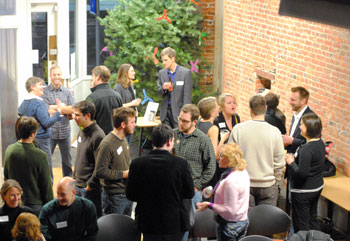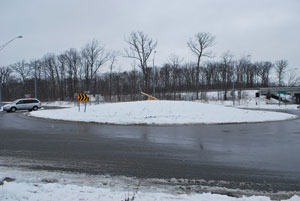Ideas Floated for South State Corridor
An informal session with University of Michigan urban planning students gave Ann Arbor planning commissioners more ideas for possible changes to the South State Street corridor.

Danielle Thoe, a University of Michigan graduate student in urban planning, explains a concept for creating a boulevard for pedestrians and bicyclists to navigate better the I-94 overpass along South State Street. (Photos by the writer.)
The Nov. 27 meeting included a presentation by four graduate students in urban and regional planning. They had analyzed the corridor between Ellsworth and Stimson, which the city has also been studying. The presentation came in the context of a draft report currently under review by planning commissioners, with more than 40 recommendations to improve the corridor. [.pdf of draft report]
The students approached their work by identifying changes that could have an immediate impact on the corridor, while also looking at more visionary, long-term goals. Shorter-term suggestions included replacing and widening sidewalks, and adding new sidewalks in sections where there are none.
A more ambitious idea is to transform the broad center turn lanes on the I-94 overpass into a protected bicycle/pedestrian median. Currently, navigating the freeway interchange on foot or by bike is daunting. The approach could serve multiple purposes. If bioswales and landscaping were in place along the outer edges, it would help with stormwater management and provide a physical barrier between vehicles and pedestrians/cyclists. The greenery would also have visual impact for people exiting the freeway, indicating that you’re entering a city that values the environment and alternative transportation, according to the students.
Creating a sense of identity along the corridor was a common theme, with an additional focus on safety issues, stormwater management, and functionality/aesthetics.
The meeting was attended by four of the eight current planning commissioners, as well as planning manager Wendy Rampson. The commission is expected to make a recommendation on the city’s draft corridor plan at either its Dec. 18 or Jan. 3 meeting. The Ann Arbor city council would need to approve the plan before any action is taken toward implementing its recommendations. [Full Story]








